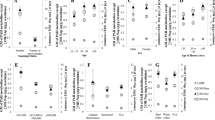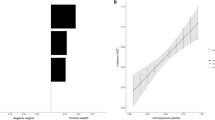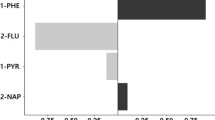Abstract
We recently reported associations between urinary 1-naphthol (1N) levels and several intermediate measures of male reproductive health, namely sperm motility, serum testosterone levels, and sperm DNA damage. However, because 1N is a major urinary metabolite of both naphthalene and the insecticide carbaryl, exposure misclassification stemming from differences in exposure source was probable and interpretation of the results was limited. As naphthalene, but not carbaryl, is also metabolized to 2-naphthol (2N), the relationship of urinary 1N to 2N within an individual may give information about source of 1N. Utilizing data from two previous studies that measured both 1N and 2N in urine of men exposed to either carbaryl or naphthalene, the present study employed several methods to differentiate urinary 1N arising from exposures to carbaryl and naphthalene among men in the reproductive health study. When re-evaluating the reproductive health data, techniques for identifying 1N source involved exploring interaction terms, stratifying the data set based on 1N/2N ratios, and performing an exposure calibration using a linear 1N to 2N relationship from a study of workers exposed to naphthalene in jet fuel. Despite some inconsistencies between the methods used to distinguish 1N source, we found that 1N from carbaryl exposure is likely responsible for the previously observed association between 1N and sperm motility, whereas 1N from naphthalene exposure is likely accountable for the association between 1N and sperm DNA damage. We demonstrate that studies of health effects associated with carbaryl should utilize a 1N/2N ratio to identify subgroups in which carbaryl is the primary source of 1N. Conversely, studies of naphthalene-related outcomes may utilize 2N levels to estimate exposure.
This is a preview of subscription content, access via your institution
Access options
Subscribe to this journal
Receive 6 print issues and online access
$259.00 per year
only $43.17 per issue
Buy this article
- Purchase on Springer Link
- Instant access to full article PDF
Prices may be subject to local taxes which are calculated during checkout
Similar content being viewed by others
References
ATSDR. Toxicological Profile for Naphthalene, 1-Methylnapthalene, and 2-Methylnapthalene. Agency for Toxic Substances and Disease Registry, Atlanta, GA, 2003.
ATSDR. Toxicological Profile for Polycyclic Aromatic Hydrocarbons (PAHs). Agency for Toxic Substances and Disease Registry, Atlanta, GA, 1995.
Barr D.B., Barr J.R., Driskell W.J., Hill Jr. R.H., Ashley D.L., and Needham L.L., et al. Strategies for biological monitoring of exposure for contemporary-use pesticides. Toxicol Ind Health 1999: 15: 168–179.
Bieniek G. Urinary naphthols as an indicator of exposure to naphthalene. Scand J Work Environ Health 1997: 23: 414–420.
Boeniger M.F., Lowry L.K., and Rosenberg J. Interpretation of urine results used to assess chemical exposure with emphasis on creatinine adjustments: a review. Am Ind Hyg Assoc J 1993: 54: 615–627.
Bravo R., Caltabiano L.M., Fernandez C., Smith K.D., Gallegos M., and Whitehead Jr. R.D., et al. Quantification of phenolic metabolites of environmental chemicals in human urine using gas chromatography-tandem mass spectrometry and isotope dilution quantification. J Chromatogr B 2005: 820: 229–236.
CDC. Second National Report on Human Exposure to Environmental Chemicals. Centers for Disease Control and Prevention. Washington, DC, 2003.
CDC. Third National Report on Human Exposure to Environmental Chemicals. Centers for Disease Control and Prevention, Washington, DC, 2005: http://www.cdc.gov/exposurereport/3rd/results.htm February 2006.
Colt J.S., Lubin J., Camann D., Davis S., Cerhan J., and Severson R.K., et al. Comparison of pesticide levels in carpet dust and self-reported pest treatment practices in four US sites. J Expo Anal Environ Epidemiol 2004: 14: 74–83.
DeMarini D.M. Genotoxicity of tobacco smoke and tobacco smoke condensate: a review. Mutat Res 2004: 567: 447–474.
EPA. Pesticide Industry Sales and Usage: 1998 and 1999 Market Estimates., Report # 773-R-02-001 United States Environmental Protection Agency, Washington, DC, 2002.
FDA. Summary of Residues Found, Ordered by Food: Market Baskets 91-301-04. United States Food and Drug Administration Total Diet Study, Rockville, MD, 2003: http://www.cfsan.fda.gov/~acrobat/TDS1byfd.pdf February 2006.
Gaspari L., Chang S.S., Santella R.M., Garte S., Pedotti P., and Taioli E. Polycyclic aromatic hydrocarbon–DNA adducts in human sperm as a marker of DNA damage and infertility. Mutat Res 2003: 535: 155–160.
Ghosh P., and Bhattacharya S. Impairment of the regulation of gonadal function in Channa punctatus by metacid-50 and carbaryl under laboratory and field conditions. Biomed Environ Sci 1990: 3: 106–112.
Hauser R., Chen Z., Pothier L., Ryan L., and Altshul L. The relationship between human semen parameters and environmental exposure to polychlorinated biphenyls and p,p′-DDE. Environ Health Perspect 2003: 111: 1505–1511.
Hill Jr. R.H., Head S.L., Baker S., Gregg M., Shealy D.B., and Bailey S.L., et al. Pesticide residues in urine of adults living in the United States: reference range concentrations. Environ Res 1995: 71: 99–108.
Kato M., Loomis D., Brooks L.M., Gattas G.F., Gomes L., and Carvalho A.B., et al. Urinary biomarkers in charcoal workers exposed to wood smoke in Bahia State, Brazil. Cancer Epidemiol Biomarkers Prev 2004: 13: 1005–1012.
Kim H., Cho S.H., Kang J.W., Kim Y.D., Nan H.M., and Lee C.H., et al. Urinary 1-hydroxypyrene and 2-naphthol concentrations in male Koreans. Int Arch Occup Environ Health 2001: 74: 59–62.
Kim H., Kim Y.D., Lee H., Kawamoto T., Yang M., and Katoh T. Assay of 2-naphthol in human urine by high-performance liquid chromatography. J Chromatogr B 1999: 734: 211–217.
Kleinbaum D.G., Kupper L.L., Muller K.E., and Nizam A. Selecting the best regression equation. In: Kugushev A (ed.) Applied Regression Analysis and Other Multivariate Methods, 3rd ed. Brooks/Cole Publishing Company, Pacific Grove, CA, 1998.
Klotz D.M., Arnold S.F., and McLachlan J.A. Inhibition of 17 beta-estradiol and progesterone activity in human breast and endometrial cancer cells by carbamate insecticides. Life Sci 1997: 60: 1467–1475.
Maroni M., Colosio C., Ferioli A., and Fait A. Biological monitoring of pesticide exposure: a review. Toxicology 2000: 143: 1–118.
Meeker J.D., Barr D.B., Ryan L., Herrick R.F., Bennett D.H., and Bravo R., et al. Temporal variability of urinary levels of nonpersistent insecticides in adult men. J Expo Anal Environ Epidemiol 2005: 15: 271–281.
Meeker J.D., Ryan L., Barr D.B., and Hauser R. Exposure to non-persistent insecticides and reproductive hormones in adult men. Epidemiology 2006: 17: 61–68.
Meeker J.D., Ryan L., Barr D.B., Herrick R.F., Bennett D.H., and Bravo R., et al. The relationship of urinary metabolites of carbaryl/naphthalene and chlorpyrifos with human semen quality. Environ Health Perspect 2004a: 112: 1665–1670.
Meeker J.D., Singh N.P., Ryan L., Duty S.M., Barr D.B., and Herrick R.F., et al. Urinary levels of insecticide metabolites and DNA damage in human sperm. Hum Reprod 2004b: 19: 2573–2580.
Nan H.M., Kim H., Lim H.S., Choi J.K., Kawamoto T., and Kang J.W., et al. Effects of occupation, lifestyle and genetic polymorphisms of CYP1A1, CYP2E1, GSTM1 and GSTT1 on urinary 1-hydroxypyrene and 2-naphthol concentrations. Carcinogenesis 2001: 22: 787–793.
Preuss R., Drexler H., Bottcher M., Wilhelm M., Bruning T., and Angerer J. Current external and internal exposure to naphthalene of workers occupationally exposed to polycyclic aromatic hydrocarbons in different industries. Int Arch Occup Environ Health 2005: 78: 355–362.
Preuss R., Angerer J., and Drexler H. Naphthalene — an environmental and occupational toxicant. Int Arch Occup Environ Health 2003: 76: 556–576.
Rappaport S.M., Waidyanatha S., and Serdar B. Naphthalene and its biomarkers as measures of occupational exposure to polycyclic aromatic hydrocarbons. J Environ Monit 2004: 6: 413–416.
Rudel R.A., Camann D.E., Spengler J.D., Korn L.R., and Brody J.G. Phthalates, alkylphenols, pesticides, polybrominated diphenyl ethers, and other endocrine-disrupting compounds in indoor air and dust. Environ Sci Technol 2003: 37: 4543–4553.
Serdar B., Egeghy P.P., Gibson R., and Rappaport S.M. Dose-dependent production of urinary naphthols among workers exposed to jet fuel (JP-8). Am J Ind Med 2004: 46: 234–244.
Serdar B., Egeghy P.P., Waidyanatha S., Gibson R., and Rappaport S.M. Urinary biomarkers of exposure to jet fuel (JP-8). Environ Health Perspect 2003a: 111: 1760–1764.
Serdar B., Waidyanatha S., Zheng Y., and Rappaport S.M. Simultaneous determination of urinary 1- and 2-naphthols, 3- and 9-phenanthrols, and 1-pyrenol in coke oven workers. Biomarkers 2003b: 8: 93–109.
Shealy D.B., Barr J.R., Ashley D.L., Patterson Jr. D.G., Camann D.E., and Bond A.E. Correlation of environmental carbaryl measurements with serum and urinary 1-naphthol measurements in a farmer applicator and his family. Environ Health Perspect 1997: 105: 510–513.
Teass A.W., Biagini R.E., DeBord G., and Hull R.D. Application of biological monitoring methods. In: Eller PM (Ed.). NIOSH Manual of Analytical Method, 4th edn. National Institute for Occupational Safety and Health, Cincinnati, OH, 1998 pp. 52–62.
USDA. USDA Pesticide Data Program: PDP Databases Available for Downloading. United States Department of Agriculture, Washington, DC, 2002: http://www.ams.usda.gov/science/pdp/Download.htm February 2006.
Waidyanatha S., Troester M.A., Lindstrom A.B., and Rappaport S.M. Measurement of hemoglobin and albumin adducts of naphthalene-1,2-oxide, 1,2-naphthoquinone and 1,4-naphthoquinone after administration of naphthalene to F344 rats. Chem Biol Interact 2002: 141: 189–210.
WHO. WHO Laboratory Manual for the Examination of Human Semen and Sperm–Cervical Mucus Interaction,;4th edn. World Health Organization, Cambridge University Press, New York, NY, 1999.
Yang M., Koga M., Katoh T., and Kawamoto T. A study for the proper application of urinary naphthols, new biomarkers for airborne polycyclic aromatic hydrocarbons. Arch Environ Contam Toxicol 1999: 36: 99–108.
Author information
Authors and Affiliations
Corresponding author
Rights and permissions
About this article
Cite this article
Meeker, J., Barr, D., Serdar, B. et al. Utility of urinary 1-naphthol and 2-naphthol levels to assess environmental carbaryl and naphthalene exposure in an epidemiology study. J Expo Sci Environ Epidemiol 17, 314–320 (2007). https://doi.org/10.1038/sj.jes.7500502
Received:
Accepted:
Published:
Issue Date:
DOI: https://doi.org/10.1038/sj.jes.7500502
Keywords
This article is cited by
-
Association between urinary biomarkers of polycyclic aromatic hydrocarbons and severe abdominal aortic calcification in adults: data from the National Health and Examination Nutrition Survey
BMC Cardiovascular Disorders (2023)
-
Biomarkers for polycyclic aromatic hydrocarbons in human excreta: recent advances in analytical techniques—a review
Environmental Geochemistry and Health (2023)
-
Urinary levels of monohydroxylated polycyclic aromatic hydrocarbons in Brazilian children and health risk assessment: a human biomonitoring-based study
Environmental Science and Pollution Research (2022)
-
Validated single urinary assay designed for exposomic multi-class biomarkers of common environmental exposures
Analytical and Bioanalytical Chemistry (2022)
-
Assessment of the exposure to polycyclic aromatic hydrocarbons in users of various tobacco/nicotine products by suitable urinary biomarkers
Archives of Toxicology (2022)



